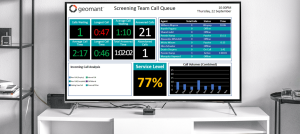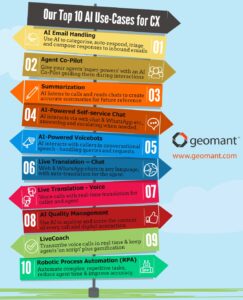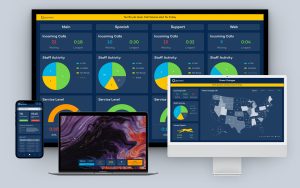Today’s contact centers are far more sophisticated and advanced than they once were.
We’re living in a world where consumers are more technically adept and comfortable seeking solutions to issues on various platforms. These customers also have much higher expectations than they once did. Many expect customer service to be delivered consistently across platforms with minimal disruption or downtime.
Ensuring you can delight and engage your customers means implementing the right contact center technology and ensuring it works as expected. So, how do you detect when your solution isn’t working for your business the way you anticipated it to?
Step 1: Track Call Quality and Consistency
One of the best ways to ensure your solutions are still working correctly is to implement tools to monitor call quality in various geographies and departments. You can set up a contact center dashboard or wallboard for different departments and monitor vital metrics, like how quickly agents resolve problems, and how many calls are lost.
If customers leave reviews of your service experience or if you are using sentiment analysis on your calls, you can use these insights to determine whether lag, call drops, or poor audio are contributing to a negative interaction. Make sure you have benchmarks in place so you know what kind of results you should be achieving.
Step 2: Keep an Eye on Employee Performance
For contact center solutions to deliver optimal results for your business, they must empower and inform your teams. If your contact center management dashboard shows your employees are consistently struggling to meet achievable goals, it may be due to outdated or unreliable technology. In addition to Customers, Agents are one of the best sources of feedback regarding contact center applications. Pay attention to how frequently employees share frustrations about poor routing techniques or complex interfaces. This could indicate problems with company training and onboarding processes, or your technology may be outdated or poorly implemented.
Step 3: Monitor Metrics across Every Channel and Team
In today’s customer service landscape, multiple teams often deal with service requests, sales, and other interactions across various channels. Business leaders must ensure their communication solutions are working on a broad scale to achieve CX results.
Fortunately, dashboards and monitoring tools can be effective for this. Companies can even set up different team wallboards, focusing on the metrics that matter most for each area. For instance, call handling rate might not be important for a message-based service team, but satisfaction score and NPS metrics are.
Step 4: Keep a Close Eye on Integrations
Implementing new solutions can be overwhelming and somewhat challenging for today’s teams, particularly as the complexity of the contact center continues to evolve. Many of the solutions leveraged by today’s workforce need to integrate and work alongside other critical tools, like CRM systems, Workforce Management or Ticketing.
If integrations aren’t delivering access to critical information correctly, or there’s no option to connect your contact center to your existing tools, this could be a sign your solution is no longer working for your company. You may need to consider upgrading to something more flexible or more in-tune with the needs of your employees.
Step 5: Look for Evidence your Solution is Out of Date
As the customer experience landscape transforms, legacy communications tools become increasingly inefficient. To thrive today, business leaders need an omnichannel environment capable of connecting interactions across various channels. These tools must be agile, easy to use, and brimming with valuable insights.
The right tools should also be tailor-made to suit the needs of different kinds of employees. As most companies discovered over the past few years, your contact center solution needs to deliver CX functionality to remote and hybrid workers. Since hybrid work is now commonplace, some systems may need to be upgraded to fully support remote workers.
Be Ready to Upgrade and Evolve
Today’s business leaders can’t afford to stick with the same contact center and communications tools if they stop delivering the right results. Failure to update and upgrade your technology could leave you struggling to keep up with the competition when it comes to delighting and engaging your customers.
Monitoring your business solutions’ performance not only provides insights into whether your tools are still working as they should, but it can also help you determine when it might be time to replace aging technology. Contact Geomant today to learn how our dashboards and wallboards can help you stay on top of your CX strategy.











